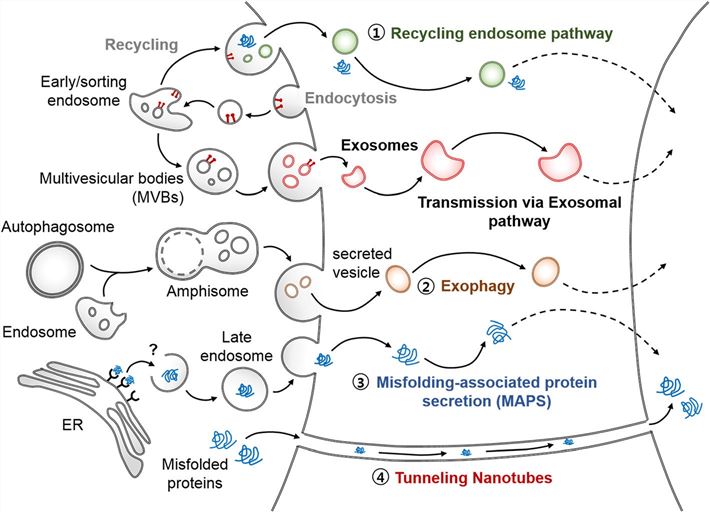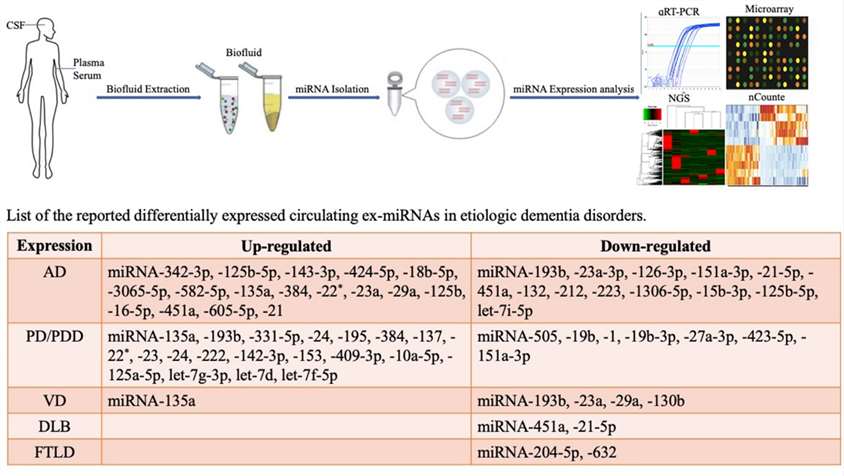Neurological Diseases Diagnosis-Applied Exosomes
With a diameter of about 40-200 nm, exosomes are membranous vesicles formed by various types of cells through a series of regulations and can be secreted outside the cells. Exosomes play the role of material transfer and information exchange by transporting mRNAs, miRNAs, lncRNAs, circRNAs, and proteins to target cells, thereby affecting the activities of target cells. As a means of intercellular communication, exosomes easily pass through the blood-brain barrier (BBB) and play an important role in the progression of Alzheimer's disease (AD), Parkinson's disease (PD), and other neurological diseases. A large number of studies on exosomes have been continuously promoting people's in-depth understanding of the mechanism of occurrence and development of neurological diseases. Moreover, more and more researchers believe that exosomes can provide potential biomarkers for early diagnosis and prognosis of neurological diseases. Creative Biolabs continues to develop deeply in the field of biotechnology and mass spectrometry detection and has key core competitiveness. We have been committed to helping customers discover biomarkers in exosomes that can be used to diagnose different neurological diseases through one-stop sequencing services.
The Role of Exosomes in the Occurrence and Development of Neurological Diseases
In the brain, almost all cells such as neural stem cells, neurons, glial cells, and endothelial cells can release exosomes. In neurological diseases, these exosomes are not only involved in the aggregation of some toxic proteins, but they are also involved in the dissemination and diffusion of these toxic proteins to lesion-free areas. These toxic proteins include amyloidβ-protein (Aβ) in AD, α-synuclein (α-Syn) in PD, Tau protein, etc. Ultimately, these exosomes activate related pathological mechanisms, leading to a series of characteristic neurodegenerative pathological changes and promoting the occurrence and deterioration of neurological diseases.
 Fig.1 Possible mechanisms of interneuronal protein aggregate transmission alternative to the one involving exosomes.1,3
Fig.1 Possible mechanisms of interneuronal protein aggregate transmission alternative to the one involving exosomes.1,3
Potential Application of Exosome Contents in the Diagnosis of Neurological Diseases
Exosomes can not only reflect the contents of their donor cells, but also reflect the physiological and pathological state of their donor cells. Due to the small size of exosomes and their ability to penetrate the BBB, changes occur early in the lesion. Based on body fluid-based liquid biopsy, exosomes can be used as a non-invasive diagnostic and prognostic tool for neurological diseases. For example, the phosphorylated tau protein content of Thr-181 was significantly increased in exosomes derived from the cerebrospinal fluid of AD patients, which can be used as a biomarker of AD. The content of exosome-derived miR-21 and miR-29a changes significantly in PD patients and can be used as a biomarker of PD. Therefore, exosomes have great clinical diagnostic potential and can be a non-invasive diagnostic tool for neurological diseases.
 Fig.2 Methodological aspects of circulating biomarker research and circulating exosome miRNAs as biomarkers for dementia disorders.2,3
Fig.2 Methodological aspects of circulating biomarker research and circulating exosome miRNAs as biomarkers for dementia disorders.2,3
With in-depth research in the related fields of the nervous system, exosomes have broad application prospects in the clinical diagnosis of neurological diseases. Creative Biolabs can provide a variety of exosome extraction services and a full range of exosome identification services to meet the different needs of customers. Please feel free to contact us if you have ideas for screening exosomes for biomarkers in the diagnosis of neurological or other diseases. We will provide you with the most comprehensive exosome sequencing services, including exosomal proteome sequencing, exosomal whole transcriptome sequencing, exosomal miRNA sequencing, exosomal lncRNA sequencing, exosomal circRNA sequencing, etc.
References
-
Lim, YJ.; Lee, SJ.; Are exosomes the vehicle for protein aggregate propagation in neurodegenerative diseases? Acta Neuropathologica Communications. 2017, 5(1):64.
-
Dong, X.; et al. Circulating exosome microRNAs as diagnostic biomarkers of dementia. Frontiers in Aging Neuroscience. 2020, 12:580199.
-
under Open Access license CC BY 4.0, without modification.
For Research Use Only. Cannot be used by patients.
Related Services:

 Fig.1 Possible mechanisms of interneuronal protein aggregate transmission alternative to the one involving exosomes.1,3
Fig.1 Possible mechanisms of interneuronal protein aggregate transmission alternative to the one involving exosomes.1,3
 Fig.2 Methodological aspects of circulating biomarker research and circulating exosome miRNAs as biomarkers for dementia disorders.2,3
Fig.2 Methodological aspects of circulating biomarker research and circulating exosome miRNAs as biomarkers for dementia disorders.2,3









